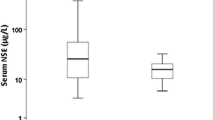Summary
Introduction: The aim of this study was to investigate the kinetic patterns of the protein S-100, a specific cerebral astroglial cell protein, and the relationship to changes of cerebral oxygenation before, during, and after corrective cardiac surgery in infants and children.¶ Methods: 63 neonates, infants and children (age range 0.2–216 months) were included. Cardiac surgery was performed using full-flow cardiopulmonary bypass with moderate hypothermia and alpha-stat strategy. Regional cerebral hemoglobin saturation was continuously determined by near infrared spectroscopy (INVOS 3100A, Somanetics®, USA). The protein S-100 serum concentrations were analyzed using a commercially available two-site immunradiometric assay kit (Sangtec® IRMA, Bromma, Schweden).¶ Results: A significant increase in serum levels of S-100 was found immediately after termination of cardiopulmonary bypass (p<0.001). The post-bypass S-100 serum levels significantly correlated with age ¶(r=–0.75, p<0.0001), weight (–0.72, p<0.005), bypass time (r=0.44, p=0.005), minimal rectal temperature (r=–0.67, p=0.004) and the decrease of regional cerebral hemoglobin saturation during reperfusion (r=–0.37, p=0.02) and at the end of cardiopulmonary bypass (r=–0.37, p=0.008).¶ Conclusion: The release patterns of S-100 in association with CPB may indicate increased cell membrane permeability of the astrocytic-endothelial cell complex forming the blood-brain barrier. The increased post-bypass serum levels of S-100 were related to younger age, longer duration of bypass, deep hypothermia and decreased regional intravascular cerebral oxygenation during reperfusion and at the termination of cardiopulmonary bypass.
Zusammenfassung
Fragestellung: Das Ziel diese prospektiven Studie war, die Serumkinetik des hirnspezifischen Markers Protein S-100, eines Gliazell- und Astrozytenproteins, in Beziehung zur kontinuierlich registrierten zerebralen Oxygenierung vor und nach Korrekturoperationen angeborener Herzfehler zu evaluieren.¶ Methodik: Die regionale zerebrale Hämoglobin-Sättigung wurde mit Hilfe der Nahinfrarotspektroskopie (INVOS 3100A, Somanetics®, USA) bestimmt und das Protein S-100 mittels eines doppelseitigen Radioimmunassays analysiert (Sangtec® 100 IRMA, Bromma, Schweden).¶ Ergebnisse: Das Protein S-100 war bei allen Kindern ohne nachweisbare neurologische Komplikationen nach Ende der extrakorporalen Zirkulation um 2 Standardabweichungen des präoperativen Ausgangswertes erhöht gefunden (p<0,0001). Die maximalen Serum-S-100-Konzentrationen korrelierten signifikant mit dem Alter (r=–0,75, p<0,0001) und Gewicht (r=–0,72, p=0,005) der Kinder, der Bypasszeit (r=0,44, p=0,005) und der minimalen rektalen Temperatur (r=–0,67, p=0,004) während der extrakorporalen Zirkulation. Ein statistischer Zusammenhang fand sich zwischen dem postoperativen Serumspiegel des Protein S-100 und dem Abfall der regionalen zerebralen Hämoglobin-Sättigung während der Reperfusion (r=–0,37, p=0,02) und am Ende der extrakorporalen Zirkulation (r=¶–0,42, p=0,008).¶ Schlußfolgerung: Die Astrogliazellen scheinen auf die extrakorporale Zirkulation mit einer Expression des Protein S-100 zu reagieren. Eine Membranschädigung im endothelialastrozytären Zellkomplex der Blut-Hirnschranke könnte die Freisetzung des Proteins in die Blutstrombahn erklären. Beeinflussende Faktoren scheinen geringes Alter, Länge der extrakorporalen Zirkulation, Grad der Hypothermie und mögliche Reduktion der postoperativen zerebralen Oxygenierung zu sein.
Similar content being viewed by others
Author information
Authors and Affiliations
Additional information
Eingegangen: 13. Januar 2000/Akzeptiert: 7. Mai 2000
Rights and permissions
About this article
Cite this article
Abdul-Khaliq, H., Weipert, T., Uhlig, R. et al. Das Serum S-100-Protein nach Korrekturoperationen angeborener Herzfehler im Kleinkindesalter: Beziehung zu Veränderungen der intraoperativen zerebralen Oxygenierung. Intensivmed 37, 617–624 (2000). https://doi.org/10.1007/s003900070037
Published:
Issue Date:
DOI: https://doi.org/10.1007/s003900070037




